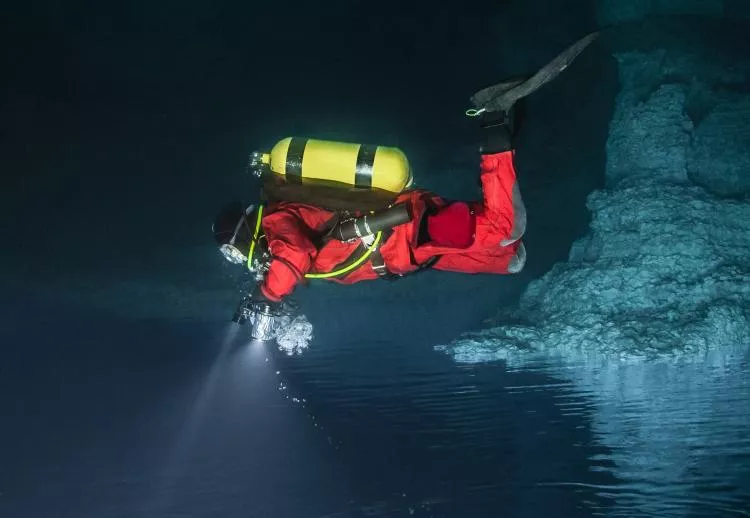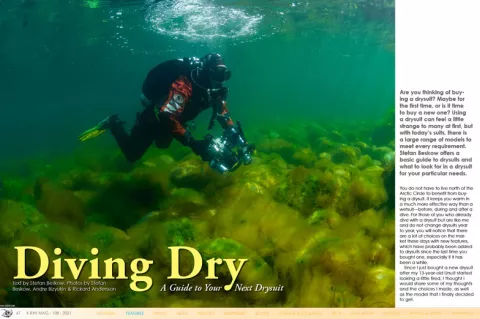Are you thinking of buying a drysuit? Maybe for the first time, or is it time to buy a new one? Using a drysuit can feel a little strange to many at first, but with today’s suits, there is a large range of models to meet every requirement. Stefan Beskow offers a basic guide to drysuits and what to look for in a drysuit for your particular needs.
Contributed by
Factfile
FURTHER READING:

"She-P: The Sea Gods' Gift to Female Divers," by Susanne Paulsen. Issue #108

"Thermal Stress: Thermal Physiology & Protection for Diving," by Dr Neal Pollock. Issue #63

"The Zen of Diving Drysuits," by Peter Symes, Andrey Bizyukin, Peter Fitschen, Hillary Child, Jim Standing, Cindy Ross, Stig Insuláns. Issue # 13
You do not have to live north of the Arctic Circle to benefit from buying a drysuit. It keeps you warm in a much more effective way than a wetsuit—before, during and after a dive. For those of you who already dive with a drysuit but are like me and do not change drysuits year to year, you will notice that there are a lot of choices on the market these days with new features, which have probably been added to drysuits since the last time you bought one, especially if it has been a while.
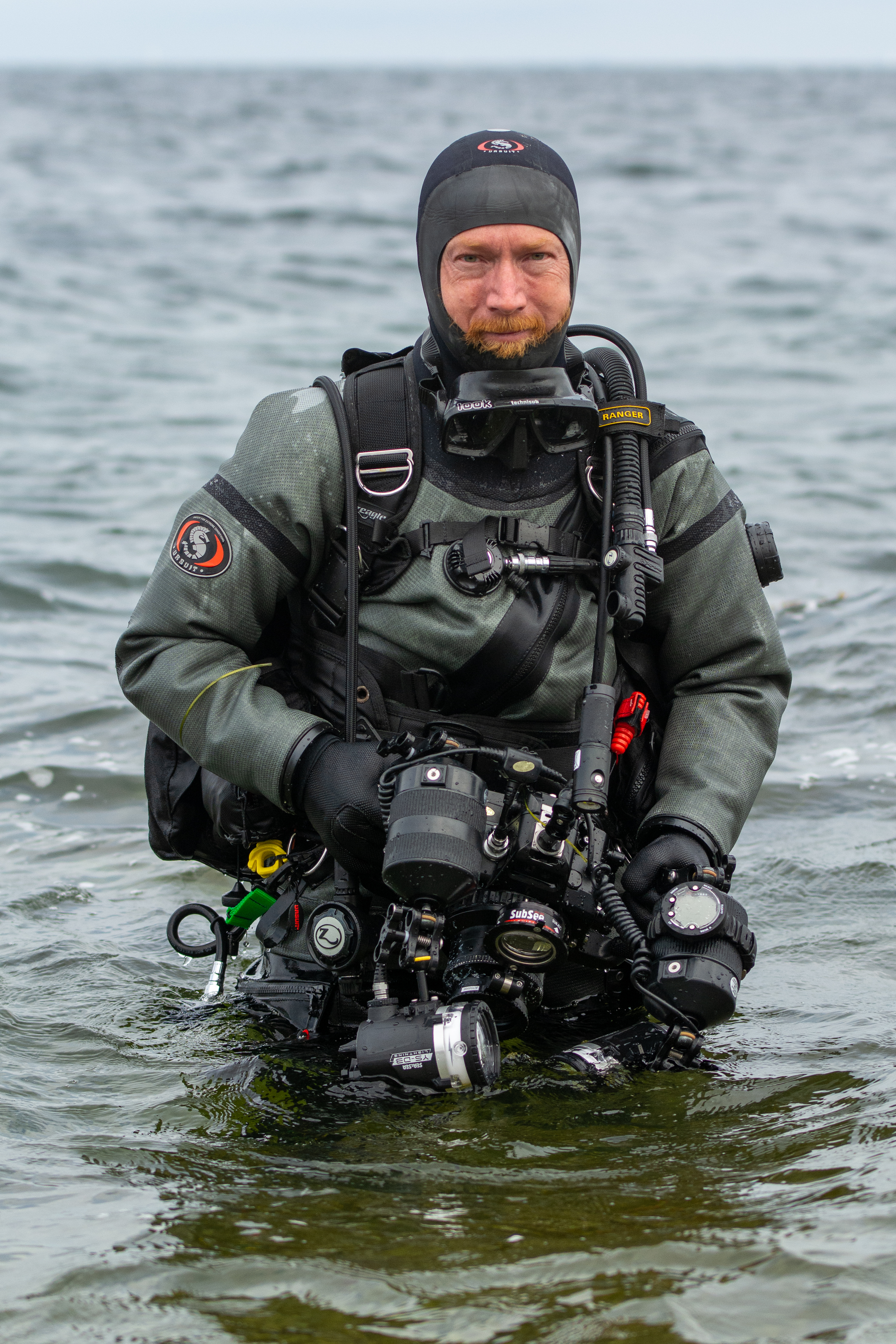
Since I just bought a new drysuit after my 13-year-old Ursuit started looking a little tired, I thought I would share some of my thoughts and the choices I made, as well as the model that I finally decided to get.
Which brand should you choose?
Today, there is a plethora of good drysuits on the market. Each brand has its advocates. What is important to keep in mind is that your drysuit should suit you! Then, it does not matter if the brand is Bare, DUI, Fourth Element, Otter, Santi, Waterproof, or another brand. I chose Ursuit this time because I was happy with my previous suit from Ursuit, and the fit was good for me. If you have the opportunity, it is a good idea to try the suit on before you buy it and get help with proper sizing from the dive store staff, as a drysuit is a fairly large investment, which will hopefully keep you dry for many years.
Material
Depending on what your preferences are, you can very easily divide drysuits into neoprene suits and shell suits. Neoprene suits have the advantage in that you do not need to wear as much thermal garments underneath them, because the neoprene itself insulates against the cold. Some divers even like the slightly tighter fit, which traps less air than a shell suit. Then there is the “dive feeling” itself, which appeals to proponents of the neoprene suit.
The downside is that the deeper you dive, the more the insulating effect decreases as the neoprene is compressed. Neoprene is quite high in buoyancy so you will need more lead weights when diving with a neoprene suit. Neoprene means that you also lose some mobility compared to a shell suit and it takes longer to dry the suit after a dive.
There are also suits made of crushed neoprene. They are thinner than regular neoprene suits and do not compress as much under pressure. You also do not need as many lead weights when diving in them, compared to a regular neoprene suit.
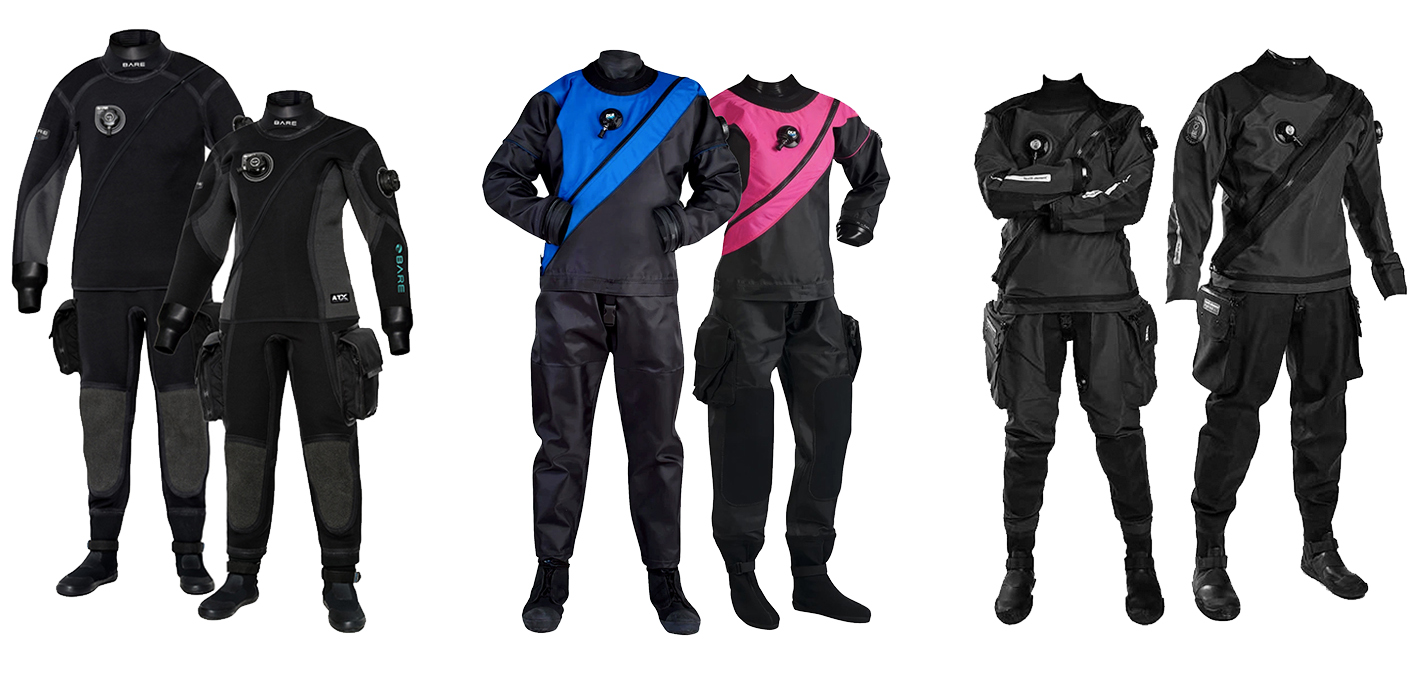
Shell drysuits
When it comes to shell suits, there are a variety of materials available, and they all have different pros and cons, so it is important to choose the material that is best suited for the type of diving you do. Different manufacturers sometimes have different designations for their materials, but in most cases, there are similar properties across most brands. It often consists of two to three (trilaminate) different layers of different materials put together to get the properties that are in demand.
When you wear shell suits, you need to wear thermal garments under the suit because the suit itself has no insulating function—preferably a high-quality undergarment, which may require that you will need to add the extra cost into your calculation. You can then easily change undergarments, depending on which season you dive—a thermal undergarment for the winter and a cooler one in the summer.
To get an overview of how many different materials are offered in shell suits, I have made a short list of different materials used in their manufacture. In this list, I refer primarily to some of Ursuit’s designations for its materials, but similar properties can be obtained from all major brands of drysuits.
Cordura. The big advantage of Cordura is that it is extremely durable. If you want a suit that can withstand tough conditions, it is often Cordura that is recommended. The downside with Cordura is that it is quite heavy (not travel-friendly) and slightly stiffer than other materials (however, there is significantly more mobility with a Cordura suit than a neoprene suit). In principle, all drysuit manufacturers have a Cordura suit in their range.
Softdura is a variant of Cordura, which is almost as durable but, as the name suggests, is slightly softer than Cordura.
Trilaminate is a much lighter suit, which is travel-friendly and is easy to move in. Despite its lightness, the material is durable.
Goretex is a lightweight material that breathes. So, if you need to travel with a drysuit, this may be a good material, but it is, however, at the expense of sustainability.
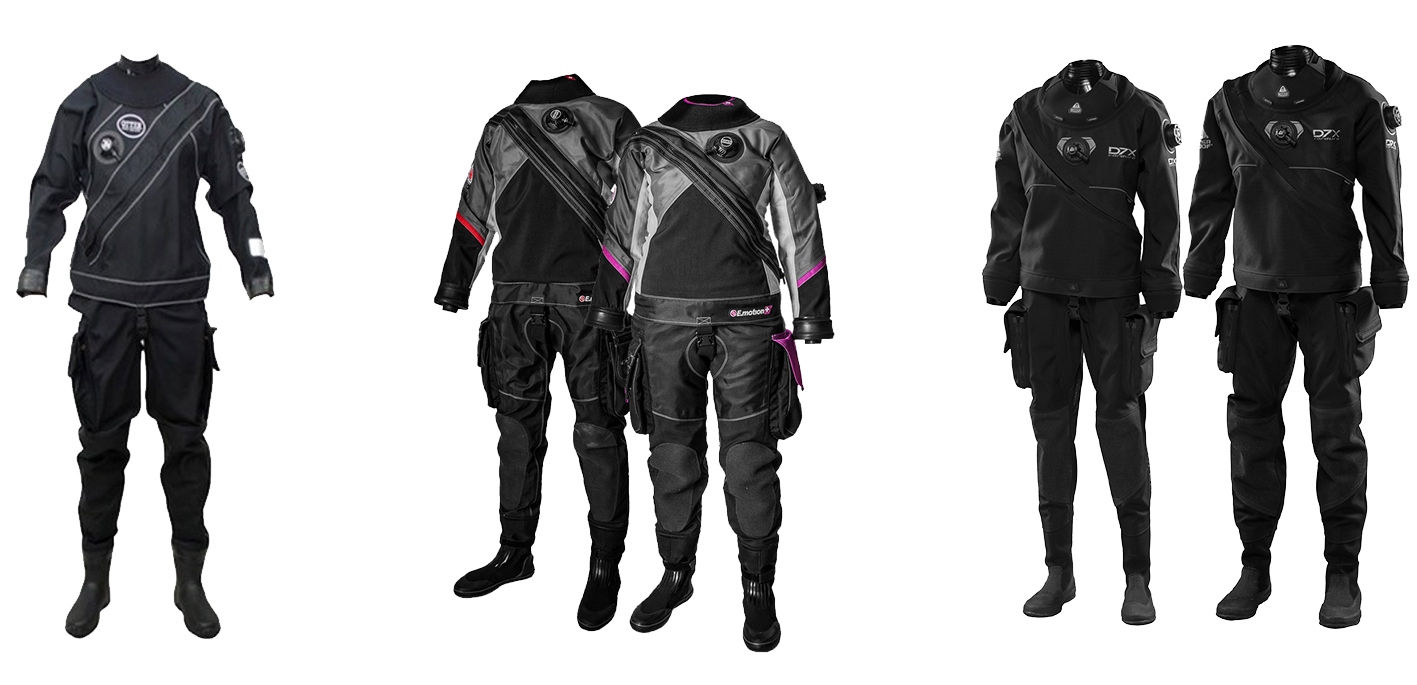
Other drysuit features
In addition to the actual material that the drysuit is made of, there are a lot of other things to consider.
Seals
Seals are available in mainly three different materials. neoprene, latex and silicone.
Latex. Is probably the most common, easy to use and holds tightness very effectively. The disadvantage of latex is that if you handle it incorrectly, there is a chance it can break. (If you handle it correctly, however, this is very unusual). Latex also ages, so you need to keep track of your seals. If they start to show small “dry cracks,” it is definitely time to change them! In addition, some people may have problems with a latex allergy and will need to use another material.
Neoprene. Neoprene is soft, lasts a long time, and does not have allergy issues. On the other hand, neoprene is not as good at keeping a tight fit, so you can often count on a few drops of water penetrating at the seals.
Silicone. Silicone is a fairly “new” material when it comes to drysuit seals and has become very popular. It is flexible, seals well, and has no allergy issues. Also, it does not wear out as much as latex.
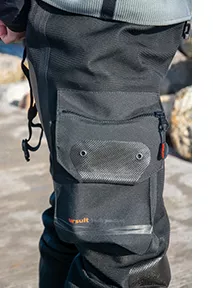
Most drysuits have one or two pockets on the leg, which can be very useful. Make sure there is a D-ring, or similar attachment, which you can use if you need to be sure that things do not fall out of your pockets underwater.
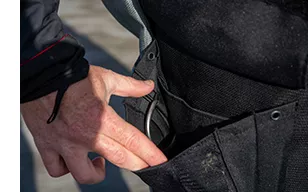
Zipper
Today, there are two types of drysuit zippers: steel and plastic. The steel zipper requires a little more care and breaks more easily if the drysuit ends up under something heavy. But if you take good care of it, it lasts a long time! The plastic zipper does not break as easily and is not as slow to pull as the steel zipper. It is basically maintenance-free but perhaps not quite as robust as the steel zipper. The plastic zipper is a very popular choice these days.
Front zip or back zip?
Both types of zippers have their pros and cons. Nowadays, the front zip is the most common placement of the zipper and allows you to put on the suit by yourself, if you do not have a buddy who can help you. Plus, the front zip does not bear as much, load-wise, from dive equipment. Back-zip suits may be a little easier to get in and out of, but as I said, you need a buddy to close and open the zipper. This can be frustrating after a long dive if you come up with a full bladder. An important detail to consider is to make sure that there is protection over the zipper itself, which can protect it from unnecessary wear.
Hood
Fixed hoods and detachable hoods both have advantages and disadvantages. The most popular is the detachable hood. It is convenient and comfortable when you are on land and do not want to wear the hood. It is easy to change the hood if it wears out or if you want a different size. If you have long hair, the detachable hood is definitely more comfortable to use. However, the fixed hood is warmer, and there is no risk that you will forget the hood on a dive.
Optional features
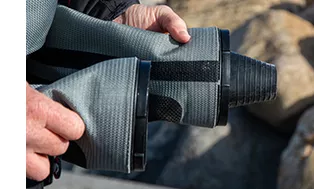
There are several different optional features. Some of the most common include:
- Rings for drysuit gloves, which are good for freezing dives, making it easy to change wrist seals even when diving with wet gloves
- Neck ring, which allows a quick change of the neck seal if the seal breaks. This can be very useful, especially if you are in places where one cannot change a fixed neck seal. It needs to be checked before diving and does not work as well with a fixed hood.
- Pee zipper for those who “always” need to urinate immediately after a dive
My choice
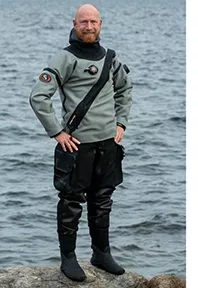
I chose the Ursuit Cordura FZ with optional ring system for dry gloves, fixed hood, steel zipper and slightly smaller boots than the standard model.
Since I dive a lot and take underwater photographs, I wanted a suit with maximum durability. Therefore, a shell suit of Cordura was the best choice. Personally, I do not think that the material is in any way so stiff that it becomes a problem when I photograph.
I chose the Ursuit brand because I was very happy with my previous suit of the same brand. I had previously had a back-zip suit but wanted the opportunity to be able to open and close the suit myself, so I chose a front-zip model. I decided to go with a steel zipper (rather than a plastic one) because it was slightly more robust. I like a fixed hood due to its increased warmth, and I believe I would probably forget to bring a detachable hood more than once!
Initial experiences
After ten dives, I can state that I am very happy with my Ursuit. It has kept me 100% dry and is very comfortable. It feels like the cut on this suit is more pliant than the previous model I used, so it generally fits me better. It is also stylish!
In the beginning, it felt strange to use a front zip, and it was a little more difficult to get in and out of this suit than the one I had before. However, I have gotten used to it now and do not think there is any major difference. The suit feels comfortable underwater, and the valves are well placed to fill and empty the suit of air. The pockets were large and easy to access. The real steel in the D-rings made it easy to attach things to them. I look forward to many dives in my new outfit! ■
Underwater photography instructor and dive writer Stefan Beskow is a teacher of mathematics and natural science based in Varberg, Sweden. His articles and underwater photographs have been published in several international magazines, and he is an ambassador for Exposure Underwater, an online underwater photography equipment sales and service provider. In addition, Beskow has created two instructional films on photography for Moderskeppet, the largest producer of online courses and e-books for digital creators in Scandinavia. He conducts underwater photography workshops and is a proud member of Naturfotograferna, a society of nature photographers in Sweden.
Further reading
"She-P: The Sea Gods' Gift to Female Divers," (full article PDF), by Susanne Paulsen. Issue #108
"Thermal Stress: Thermal Physiology & Protection for Diving," (full article PDF), by Dr Neal Pollock. Issue #63
"The Zen of Diving Drysuits," (full article PDF), by Peter Symes, Andrey Bizyukin, Peter Fitschen, Hillary Child, Jim Standing, Cindy Ross, Stig Insuláns. Issue # 13

